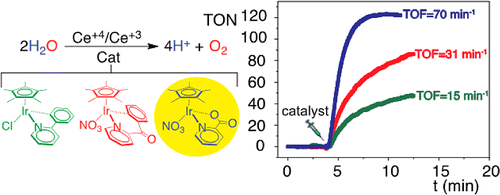Organometallic compounds [Cp*Ir(κ2-N,O)X] (κ2-N,O = 2-pyridinecarboxylic acid, ion(-1) (1), 2,4-pyridinedicarboxylic acid, ion(-1) (2), 2,6-pyridinedicarboxylic acid, ion(-1) (3); X– = Cl– (a), NO3- (b)) and [Ir(κ3-N,O,O)(1-κ-4,5-η2-C8H13)(MeOH)] (κ3-N,O,O = 2,6-pyridinedicarboxylic acid, ion(-2) (4)) are effective catalysts for the oxidative splitting of water to O2 driven by Ce4+. They show similar TOFLT values (long-term TOF, 2.6-7.4 min-1) while TOFIN values (initial TOF) strongly depend on the catalyst (1 2 > 3 > 4), reaching a maximum value of 287 min-1 (4.8 s-1) for 1a, which is the highest TOF value ever reported for an iridium catalyst. Voltammetric measurements indicate that the oxidative processes of compounds 1-4 are located at values substantially less positive than that of [Cp*Ir(bzpy)NO3] (bzpy = 2-benzoylpyridine; ΔE ≈ 0.2-0.3 V), taken as reference catalyst for water oxidation. In particular, compound 3, having a pendant -COOH moiety in close proximity to an iridium coordination site, as shown by the structure determined by single-crystal X-ray diffraction, exhibits several low-potential oxidation processes.
